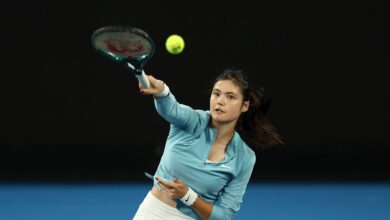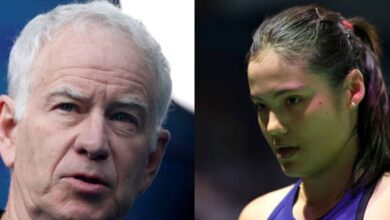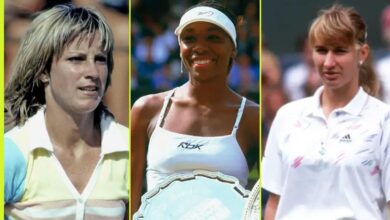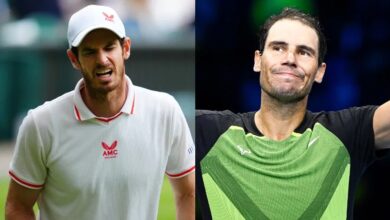Even Emma Raducanu does not believe her own mixed messages anymore
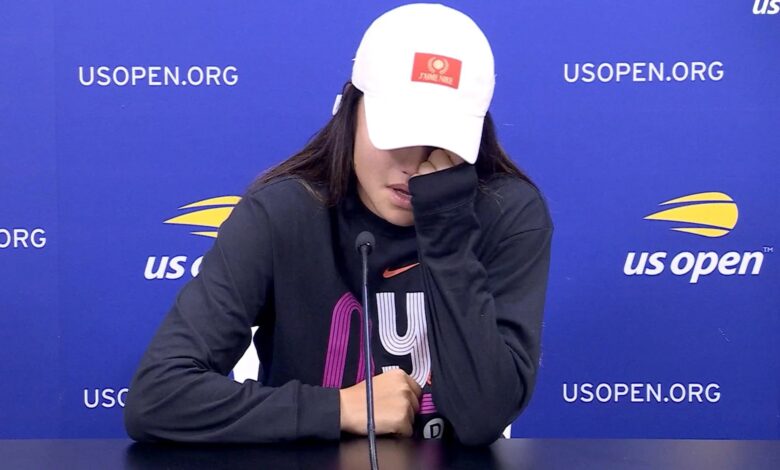
The instinct always is to afford Emma Raducanu the benefit of the doubt. As architect of the most astounding, logic-defying achievement in British sport, she has earned the latitude to plot her own path. But it is reaching the point, with her first-round US Open defeat completing a third full year without winning more than three matches at the same tournament, where her pick-and-choose approach to scheduling makes you want to scream. It is not simply that the excuses are wearing thin. It is that even she, tearfully describing the inexplicable move to head home for three weeks – just as her peers were pounding the North American hard courts – as a “collective call”, seems not even to believe what she is saying any longer.
All summer, Raducanu’s decisions have confounded rational thinking. Her justification for swerving the Paris Olympics, claiming that it was “just not the right time for me this year”, felt strangely blasé and off-hand from a 21-year-old. Trading a potentially once-in-a-lifetime chance for a second-tier tour stop in Washington? Even her compatriot Heather Watson said: “I can’t comprehend it.” And yet still it seemed prudent to reserve judgment. Surely, after convalescing from two wrist surgeries, she knew her own body best of all. Perhaps we would see the wisdom when she scripted a rousing encore to her fairytale of New York.
Except no such magic materialised. In losing to Sofia Kenin in a battle of the one-slam wonders, Raducanu looked undercooked, her weariness in the third set a testament to her lack of match sharpness. But was this not the exact problem her Olympic no-show had been designed to solve? By forsaking the Roland Garros clay in favour of a full-bore, late-summer hardcourt swing, she was meant to be building towards the tournament that launched her as the face of everything, from Dior to Porsche. And then, just as she appeared to be building momentum by advancing to the Washington quarter-finals, she flew back to London, not hitting another competitive ball until Flushing Meadows.
This is no way to mobilise for any tournament, never mind a major. Serena Williams might have been able to do it, coming agonisingly close to a calendar Grand Slam in 2015 despite playing only 11 times. But Raducanu is not, by any gauge, in the same stratosphere as Serena. She is still a relative ingénue, finding her way in an unforgiving sport. All the more reason, then, to submit to the grind, to iron out the deficiencies through relentless repetition. You wonder, though, whether she truly has the appetite. Given the chance to reach the Masters events in Toronto and Cincinnati the hard way, through qualifying, she chose training in Roehampton instead.
Contrast this attitude with that of Naomi Osaka, who is enduring an arduous return after giving birth to her first child. Osaka has won not just one major title, but four, and still she saw no downside in entering Cincinnati qualifying. In New York, you saw why, with the preparation helping her to a straight-sets victory over Jelena Ostapenko, the former French Open champion. The question is whether those around Raducanu consider such unglamorous graft beneath her. Do her blue-chip sponsors truly want to see her scampering around a deserted court in Mason, Ohio? Or would they rather watch under the dazzling arc lights of a New York night session?
The answer is self-evident. After all, Raducanu turned up to her press conference wearing a Nike “NYC” top. But she gave the impression of second-guessing certain choices, admitting: “I would have preferred probably to play a little bit more.” The wording suggested that the decision had not been hers to make. All through her growing pains on tour, there has been a sense of too many conflicting voices disrupting her focus, with Dmitry Tursunov – just one of a constantly-moving cab rank of coaches – claiming that there were “red flags I just couldn’t ignore” when he left the camp. Quite apart from the on-court confusion, there are all the commercial suitors to keep happy, with her agent Max Eisenbud justifying her plethora of endorsement deals in 2021 by saying: “The iron is hot – and we’re striking.”
Well, the iron is now decidedly cold. While injury-free at last, Raducanu looks hopelessly confused as to how to recapture that devil-may-care spirit she showed in scything through the US Open draw without dropping a set. One minute, she strikes a defiant note, shrugging that she has never been the 30-events-a-season type. The next, she sounds full of self-doubt, acknowledging that she should have competed more.
It is long past time that she seized control of her own destiny, rather than deferring to the “collective” view of managers, hangers-on, and coaches who barely last five minutes. There is, still, once you ignore the cruelties of the online trolls, an enormous stock of public goodwill behind Raducanu. You saw it at Wimbledon last month, when she showed flashes of the sparkling, irrepressible character who swept all before her at 18. And you want to believe that this version still exists. But if she is ever to rekindle those teenage kicks, she must decide where her priorities lie. This is not the junior circuit any longer, where she could waft in and out as she pleased. This is elite sport, where compromises seldom work. Raducanu needs, quite frankly, to develop the elite mentality to match.
